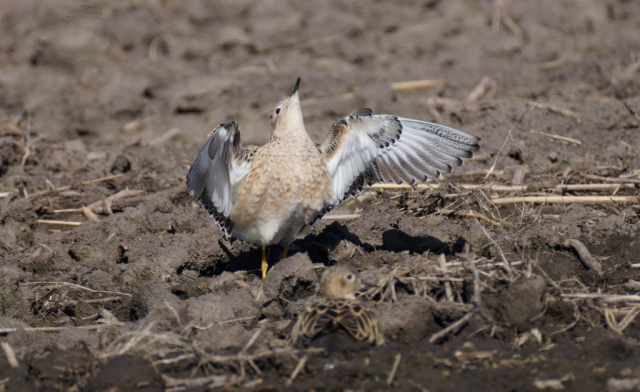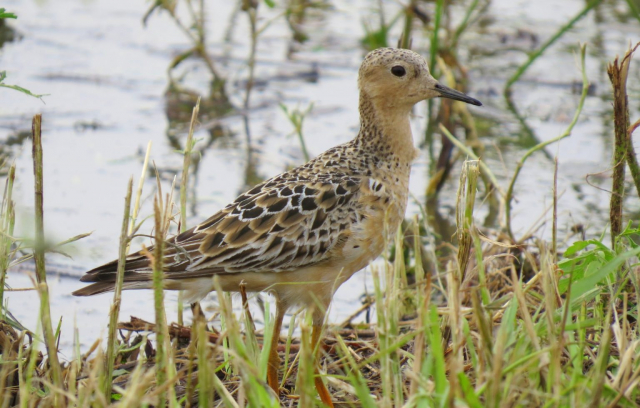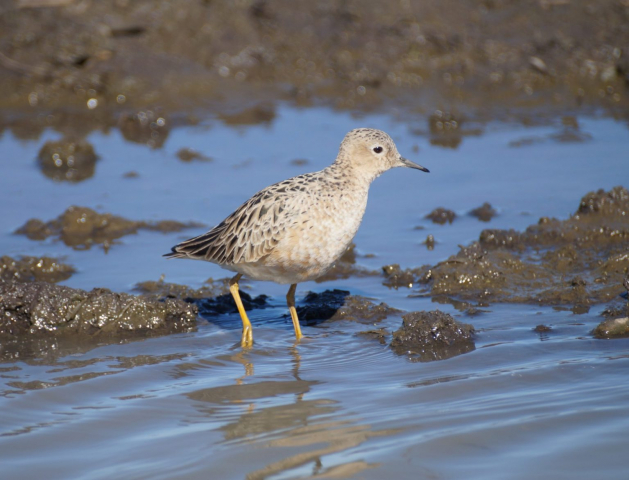Calidris subruficollis
Status: Fairly common, locally common, regular spring migrant Rainwater Basin, uncommon eastward, rare westward. Uncommon fall migrant east and central, rare west.
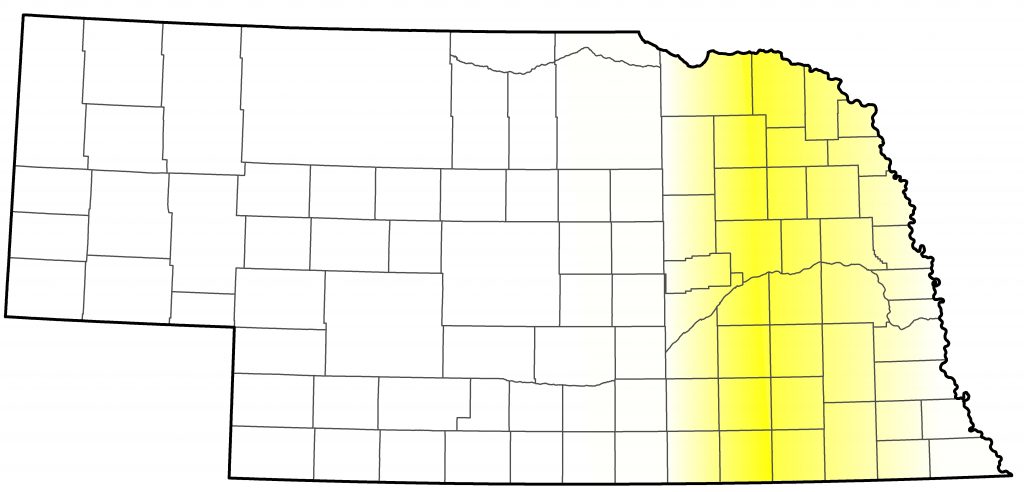
Documentation: Specimen: UNSM ZM6199, 12 Sep 1904 Lancaster Co.
Taxonomy: No subspecies are recognized (AviList 2025).
This species was formerly placed in the genus Tryngites, but recent genetic studies place it in Calidris (Chesser et al 2013).
Spring: Apr 25, 25, 26 <<<>>> May 30, 30, 31
There is an earlier record of one photographed at Moger WPA, Clay Co 13 Apr 2006 (Jorgensen 2012) and six were at Harvard WPA, Clay Co 22 Apr 2006 (Jorgensen 2012).
Later records are in Jun, and consist of only these five reports: singles at Harvard WPA, Clay Co 5 Jun and Waco WPA, Seward Co 26 Jun (Jorgensen 2012); other Jun records are of one near Massie WPA in Clay Co 7 Jun 2017, one at Tamora WPA, Seward Co 17 Jun 2014, and two at Hultine WPA, Clay Co 22 Jun 2008 (Jorgensen 2012).
In spring, Buff-breasted Sandpipers migrate through a narrow corridor on the eastern Great Plains (McCarty et al 2015, Lanctot et al 2016). One of the most important stopover sites in North America during spring is the eastern portion of the Rainwater Basin (Morris 1978, Jorgensen et al 2008), where the largest numbers in Nebraska are observed. The only notable concentration observed outside of the Rainwater Basin, albeit directly north of this region, was the 321 individuals found in fields adjacent to a playa wetland in Antelope Co 15 May 2006. Mean (average) estimates of the number of individuals stopping over in the eastern portion of the Rainwater Basin were 76,000 and 34,000 in 2004 and 2005, respectively (Jorgensen et al 2008). At the time, these totals exceeded the 30,000 individuals believed to comprise the species’ entire population (Morrison et al 2001), but the population estimate was subsequently revised to 56,000 (estimated range = 35,000–78,000) based on the information from the Rainwater Basin (Jorgensen et al 2008) and information from elsewhere (Andres et al 2012). Buff-breasted Sandpiper migrates through the Rainwater Basin during May with the largest numbers passing through during the relatively brief period of 9-18 May (Morris 1978, Jorgensen et al 2008). Buff-breasted Sandpipers arrive with heavy fat loads and individual stopover periods are relatively brief, as little as 24 hours, before birds continue their migration (McCarty et al 2015). Buff-breasted Sandpipers primarily use agricultural fields during their stopover in the Rainwater Basin and prefer fields that were planted to soybeans (Glycine max) during the previous growing season over fields planted to corn (Zea mays; Jorgensen et al 2007). Buff-breasted Sandpipers regularly visit wetlands for brief periods during late afternoons where they bath, preen, rest and engage in social interactions (McCarty et al 2009).
Spring reports west of the mapped corridor are few, only about 30 in all, and only these in the west central and west: 23 April 1935 Lincoln (Tout 1947), 11 May 1985 Clear Creek WMA, Garden and Keith Cos (Rosche 1994), and 22 May 1939 Logan Co.
- High counts: 850 in the eastern Rainwater Basin 17 May 2008 (including 622 in a single field), 700 near Kirkpatrick Basin South WMA, York Co 10 May 2006, and 627 in the eastern Rainwater Basin 20 May 2006 (522 of which were in two agricultural fields).
A total of 2172 and 3457 individuals were counted in the eastern Rainwater Basin in May during the surveys referenced above (Jorgensen et al 2008). High counts in the York Co area by Lee Morris were in the hundreds, but no specific data have been published (see Comments).
Fall: Jul 22, 22, 24 <<<>>> Sep 17, 19, 20
Earlier dates are 18 Jul 2025 Siouxland Sod Farm, Dakota Co, and 20 Jul 2018 Saunders Co.
Later dates are 23 Sep 2011 Saunders Co, 27 Sep Rainwater Basin (Jorgensen 2012), 29 Sep 2022 Kirkpatrick North Basin WMA, York Co, 30 Sep 2024 (6) Gretna, Sarpy Co, and 18 Oct 2015 Clay Co (eBird.org).
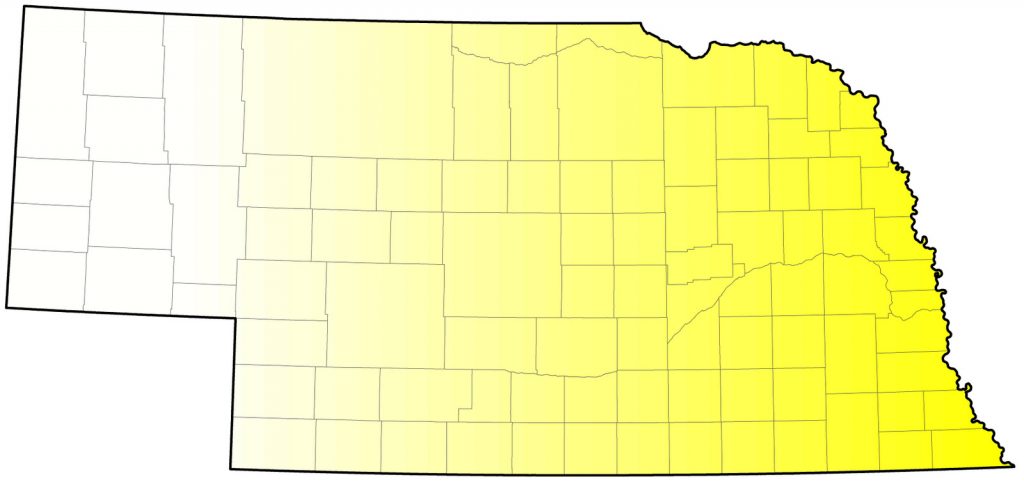
Migration generally commences in late July and early August and occasionally large numbers are observed. This early movement likely represents the principal period when adults migrate through the state. Thereafter, only smaller numbers, which are mostly juveniles, are observed through mid-Sep.
Buff-breasted Sandpipers are more widespread in fall than in spring, although high counts are still from the eastern portion of the Rainwater Basin where the species is often observed at drying wetlands and recently mowed hayfields. An overall reduction in the number of hayfields in the region over the past two decades has made the species more difficult in find. The few reports from western Nebraska are during late Aug-Sep and are presumably juveniles, although one at Lake McConaughy, Keith Co 30 Jul 2006 was believed to be an adult and the early date suggests this is likely the case. Panhandle reports, which are likely of juveniles based on the dates of occurrence, are 25 Aug 2024 Smith Lake, Morrill Co, 3 Sep 2024 Lake Minatare, Scotts Bluff Co, 4 Sep 1993 Dawes Co, 6 Sep 2021 two adjacent locations 2-3 near Big Springs, Deuel Co, 7 Sep 2017 Lake Minatare, Scotts Bluff Co, 14 Sep 1974 Scotts Bluff Co, and 2-3 at Lake Minatare 6-12 Sep 1998.
One of the 17 Jul dates above is a specimen, UNSM ZM6198, taken 1919 in Lancaster Co (Mickel and Dawson 1920).
- High counts: 317 at the Meat Animal Research Center, Clay Co, 30 Jul 2003, 283 in the eastern portion of the Rainwater Basin 2 Aug 2003 (including 151 near Goehner, Seward Co), and 97 in the eastern portion of the Rainwater Basin 13 Aug 2000.
Comments: York Co birder and farmer Lee Morris was the first to note and publish information (Morris 1978) about Buff-breasted Sandpiper stopover in the Rainwater Basin. Morris routinely observed Buff-breasted Sandpipers following behind his farming implements as he worked a field and described the species as “very common”; he stated: “lots of days there are several hundred” (Morris 1978). Morris later stated (Jorgensen 2007) that Buff-breasted Sandpipers were formerly so common that they would regularly be hit along county roads by passing traffic. He also noted that he observed extensive mortality due to the use of the granular pesticide Carbofuran (Furadan), which has been shown to cause extensive bird mortality (Balcomb et al 1984). The granular form of the pesticide was banned in 1991 in the United States. Since Morris’s discovery, several studies have examined the species stopover ecology in the eastern portion of the Rainwater Basin (Jorgensen 2007, Jorgensen et al 2008, McCarty et al. 2009, McCarty et al 2015, Brown 2018).
There is a specimen in the University of Iowa Talbot Collection, SUI 10630, collected at “Valley: North Loup”, presumably Valley Co, 2 Aug 1884; the label has a question mark after the year.
Images
Abbreviations
SUI: University of Iowa Museum of Natural History
UNSM: University of Nebraska State Museum
WMA: Wildlife Management Area (State)
WPA: Waterfowl Production Area (Federal)
Acknowledgement
John P. McCarty reviewed an earlier draft of this species account and provided numerous helpful comments that improved the content and composition.
Literature Cited
Andres, B.A., P.A. Smith, R.I.G. Morrison, C.L. Gratto-Trevor, S.C. Brown, and C.A. Friis. 2012. Population estimates of North American shorebirds, 2012. Wader Study Group Bulletin 119: 178–194.
AviList Core Team, 2025. AviList: The Global Avian Checklist, v2025. https://doi.org/10.2173/avilist.v2025.
Balcomb, R., C.A. Bowen, D. Wright, and M. Law. 1984. Effects on wildlife of at-planting corn applications of granular carbofuran. The Journal of Wildlife Management 48: 1353-1359.
Brown, L. 2018. Habitat use and behavior of migrating shorebirds in agricultural fields in the Rainwater Basin, Nebraska. Master’s Thesis, University of Nebraska at Omaha, Omaha, Nebraska, USA.
Chesser, R.T., K.J. Burns, C. Cicero, J.L. Dunn, A.W. Kratter, I.J. Lovette, P.C. Rasmussen, J. V. Remsen, Jr., J.D. Rising, D.F. Stotz, and K. Winker. 2017. Fifty-eighth supplement to the American Ornithological Society’s Check-list of North American Birds. Auk 134: 751-773.
Jorgensen, J.G. 2007. Buff-breasted Sandpiper (Tryngites subruficollis) abundance, habitat use, and distribution in the Rainwater Basin, Nebraska. Master’s Thesis, University of Nebraska at Omaha, Omaha, Nebraska, USA.
Jorgensen, J.G. 2012. Birds of the Rainwater Basin, Nebraska. Nebraska Game and Parks Commission, Lincoln, Nebraska, USA.
Jorgensen, J.G., J.P. McCarty & L.L. Wolfenbarger. 2007. Landscape and habitat variables affecting Buff-breasted Sandpiper Tryngites subruficollis distribution during migratory stopover in the Rainwater Basin, Nebraska, USA. Wader Study Group Bulletin 112: 45-51.
Jorgensen, J.G., J.P. McCarthy, and L.L. Wolfenbarger. 2008. Buff-breasted Sandpiper density and numbers during migratory stopover in the Rainwater Basin, Nebraska. Condor 110: 63-69.
Lanctot, R.B., S. Yezerinac, J. Aldabe, J. Bosi de Almeida, G. Castresana, S. Brown, P. Rocca, S.T. Saalfeld, and J.W. Fox. 2016. Light-level geolocation reveals migration patterns of the Buff-breasted Sandpiper. Wader Study 123: 29–43.
McCarty, J.P., J.G. Jorgensen, J.M. Michaud, and L.L. Wolfenbarger. 2015. Buff-breasted Sandpiper stopover duration in the Rainwater Basin, Nebraska, in relation to the temporal and spatial migration patterns in the Great Plains of North America. Wader Study 122: 243-254.
McCarty, J. P., J.G. Jorgensen & L.L. Wolfenbarger. 2009. Behavior of Buff-breasted sandpipers (Tryngites subruficollis) during migratory stopover in agricultural fields. PLos one 4. DOI: 10.1371/journal.pone.0008000.
Mickel, C.E., and R.W. Dawson. 1920. Some interesting records of Nebraska birds for the year 1919. Wilson Bulletin 32: 73-79.
Morris, L. 1978. Buff-breasted Sandpipers. NBR 46: 77–79.
Morrison, R.I.G., B.J. McCaffery, R.E. Gill, S.K. Skagen, S.L. Jones, G.W. Page, C.L. Gratto-Trevor & B.A. Andres. 2006. Population estimates of North American shorebirds, 2006. Wader Study Group Bulletin 111: 67–85.
Rosche, R.C. 1994. Birds of the Lake McConaughy area and the North Platte River valley, Nebraska. Published by the author, Chadron, Nebraska, USA.
Tout, W. 1947. Lincoln County birds. Published by the author, North Platte, Nebraska, USA.
Recommended Citation
Silcock, W.R., and J.G. Jorgensen. 2025. Buff-breasted Sandpiper (Calidris subruficollis). In Birds of Nebraska — Online. www.BirdsofNebraska.org
Birds of Nebraska – Online
Updated 22 Aug 2025
